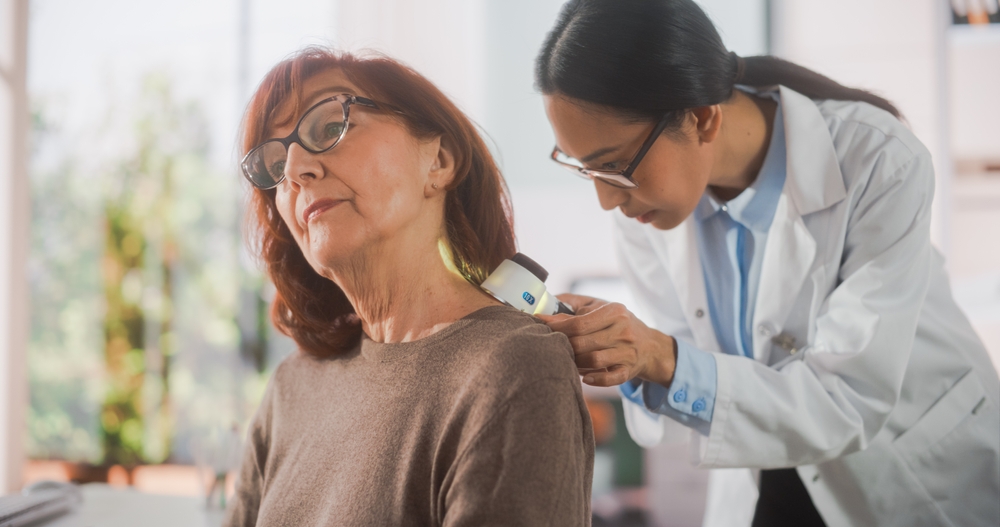
Skin cancer is a growing health concern. Especially in sunny regions like Australia, where the harsh UV rays put everyone at risk.
It’s easy to dismiss a new mole or discoloured skin patch as nothing serious. But these minor signs can signal something dangerous.
Early detection and treatment make skin cancer highly manageable. And prevent serious health complications. In this blog post, we will help you understand its causes, symptoms, and treatment options. So, you can safeguard the well-being of you & your loved ones.
At Iluka Medical Centre, our experienced practitioners are committed to providing high-quality patient-focused care. We offer comprehensive skin cancer screening and treatment services in a state-of-the-art facility. Making expert care accessible to Perth residents.
Let’s start our skin cancer guide.
What is Skin Cancer?
Skin cancer occurs when abnormal skin cells grow uncontrollably due to DNA damage. This damage can be caused by ultraviolet (UV) radiation from the sun or tanning beds. Skin cancer can affect any part of the body. Although areas frequently exposed to sunlight are more at risk. E.g.
- Face
- Neck
- Arms
While some types of skin cancer grow slowly and rarely spread. Others, like melanoma, spread rapidly and can be life-threatening if not caught early. Let’s know more about its types.
Types of Skin Cancer
Skin cancer is broadly classified into three main types, each with unique characteristics and risks:
1. Basal Cell Carcinoma (BCC)
Prevalence: Most common type of skin cancer.
Appearance: A pearly or flesh-coloured bump. It can have visible blood vessels or a central indentation.
Growth: Slow-growing and unlikely to spread.
Risk Factors: Prolonged UV exposure.
2. Squamous Cell Carcinoma (SCC)
Prevalence: Second most common type of skin cancer.
Appearance: A scaly red patch, wart-like growth, or a sore that doesn’t heal.
Growth: Can spread to other parts of the body if left untreated.
Risk Factors: Chronic sun exposure and a history of precancerous skin conditions.
3. Melanoma
Prevalence: Less common but more dangerous than BCC and SCC.
Appearance: Looks like a new mole or changes in an existing mole. Featuring asymmetrical shapes, uneven borders, and multiple colours.
Growth: Rapidly spread to other organs, making early detection crucial.
Risk Factors: UV exposure, family history, and fair skin.
BCC and SCC are more common types of skin cancers, making up about 99% of them. They are also called non-melanoma skin cancer or keratinocyte cancer. Now let’s move toward the causes.
Skin Cancer Causes
Several factors contribute to the risk and development of skin cancer.
They include:
- Repeated and unprotected exposure to the sun’s UV rays (95% of skin cancers caused).
- Artificial UV light exposure from tanning devices.
- Individuals with light skin, freckles, and light-coloured eyes.
- Family history and genetic predisposition.
- Weakened immune system due to conditions like HIV or medications suppressing immunity.
- Exposure to harmful carcinogens, such as arsenic.
- Smoking cigarettes.
Fortunately, if skin cancer is identified and treated in early stages, it can be cured. So, it’s important to keep an eye on its symptoms and causes.
Skin Cancer Symptoms & Signs
Recognising the symptoms of skin cancer early helps in treating it effectively. Symptoms can vary depending on the type of skin cancer but generally include:
| Symptom | Description |
| Persistent Growths | New or unusual growths, sores, or lumps on the skin that don’t heal. |
| Changes in Moles | Existing moles that increase in size, change colour, or become irregular. |
| Bleeding or Itching | Lesions that itch, bleed, or form a crust. |
The ABCDE Rule helps in identifying potential melanomas:
- A – Asymmetry: One half of the mole doesn’t match the other.
- B – Border: Irregular or poorly defined edges.
- C – Colour: Multiple colours or uneven distribution of them.
- D – Diameter: Larger than 6mm (about the size of a pencil eraser).
- E – Evolution: Changes in size, shape, or symptoms over time.
Whenever you spot a new mole on your skin. Assess it for the above-mentioned characteristics. And if you find any warning signs, consult a specialist for a proper diagnosis.
Diagnosis of Skin Cancer
Accurate diagnosis begins with a thorough skin examination by a qualified medical professional. Doctors use advanced diagnostic tools, like dermatoscopes, to check suspicious lesions. Further testing will be needed to confirm that diagnosis.
If necessary, a biopsy can also be performed to confirm the presence of cancerous cells. Your doctor will remove the suspicious-looking skin for lab testing. It will determine the presence of skin cancer as well as the type of it.
Early diagnosis prevents the cancer from spreading to other parts of the body. And increases the chances of successful treatment.
Skin Cancer Treatments | How Many Options Are There?
The treatment choice depends on the type, size, location, and stage of skin cancer. Small skin cancers on the surface can be treated & removed only by a biopsy. Others will require a more extensive procedure.
The following options are commonly used in the treatment of skin cancers.
1. Surgical Excision
Excision is used for almost all types of skin cancers. The cancerous lesion and its margin of healthy tissue are surgically removed. Some normal surrounding skin will also be removed if tumour is large.
It is highly effective for most cases of BCC and SCC.
2. Mohs Surgery
Mohs surgery treats larger, recurring or difficult-to-treat skin cancers (SCC & BCC both). It is a precise technique that removes cancer layer by layer with help of a microscope.
Loss of healthy tissue is minimal in it. So, areas where conserving the skin is important can benefit from it, e.g. face & nose.
3. Cryosurgery
This procedure involves freezing of cancerous cells with liquid nitrogen. The dead tissue sheds off when it thaws. A circular blade (curet) is then used to excise the growth boundaries.
It is a simple and quick procedure used for precancerous conditions or early-stage cancers.
4. Radiation Therapy
High-energy rays are used in radiation therapy to target and destroy cancer cells. E.g. x-rays. It is a relatively less painful procedure used for larger or inoperable tumours.
The remains of surgically excised cancers can also be removed by radiation therapy.
5. Chemotherapy
In chemotherapy, drugs are used to kill cancer cells. These drugs can be topical in the form of creams or lotions for superficial skin cancers.
Systemic drugs will be used if cancer has metastasised to other parts of the body.
6. Photodynamic Therapy
This treatment destroys skin cancer cells with a laser light.
Prior to that, topical drugs are applied that make cancer cells sensitive to light.
7. Immunotherapy and Targeted Therapies
These therapies are used to stimulate the body’s immune system. Or target specific mutations in melanoma cells.
But keep in mind that none of the treatment options guarantee complete cancer removal, especially in later stages. The best way is to keep yourself safe from the harms of cancer. Because prevention is always better than the cure.
How to Stay Safe from Skin Cancer? Preventive Measures
Preventing skin cancer requires sun safety as its primary measure. Here are some effective ways to keep yourself safe.
| Preventive Measure | Description |
| Sunscreen Use | Apply broad-spectrum sunscreen (SPF 30+ or higher) daily, even on cloudy days. |
| Protective Clothing | Wear hats, sunglasses, and long-sleeved clothing when outdoors. |
| Shade | Avoid direct sunlight during peak hours (10 AM–4 PM). |
| Regular Skin Checks | Self-examine your skin monthly and schedule professional checks annually. |
| Avoid Tanning Beds | Keep yourself away from the concentrated UV radiation from tanning devices. |
Along with preventive measures, regular screening sessions are also important to rule out any risk factor.
Skin Cancer Screening
Routine skin cancer screening is vital for early detection and effective treatment. During these examinations, doctors assess moles, freckles, and other skin irregularities to identify potential issues early.
At Iluka Medical Centre, we offer a thorough skin and mole check for cancer screening. The services provided by our skin cancer clinic include:
- Full Body Skin Check: Head-to-toe skin examination for early detection of skin malignancies.
- Biopsy and Analysis: Collection of skin samples for accurate diagnosis and early detection of skin cancer.
- Treatment and Surgery: Treatment plans according to type and location of skin cancer. Including surgical options if necessary.
- Follow-up Care & Monitoring: Holistic care & support from a dedicated multidisciplinary team.
Through routine screenings, you can detect abnormalities before they progress. Improving your chances of effective treatment.
Takeaways
Skin cancer is a serious yet preventable condition. Understanding the basic skin cancer information. E.g. its causes, symptoms, and available treatments can help individuals take control of their health.
Take the required preventive measures. Arrange regular professional screenings. And seek expert medical advice in case of any doubt. These measures will significantly reduce your risk of skin cancer.
Searching for Skin Cancer Screening & Treatment Services in Perth?
Trust Iluka Medical Centre for Comprehensive Skin Cancer Care
At Iluka Medical Centre, we offer expert skin cancer diagnosis, screening, and treatment services. With over two decades of healthcare experience. Our skin cancer clinic Perth combines advanced technology with compassionate care. Open seven days a week. We make convenience and accessibility possible for all our patients.
Whether you need a routine check, advanced treatment, or guidance about skin cancer facts. Our skilled doctors are here to provide the best possible care and advice.
Book Your Appointment Today and take the first step toward healthier skin.

